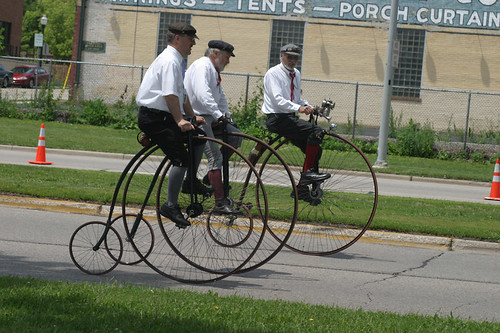
Ride the Drive, June 2010, Madison. Photograph by Darryl Jordan. All rights reserved.
I've been having fun perusing through the Bike Fed's archives recently, and ran across this article by Jim Guthrie, a member of the Bike Fed and The Wheelmen, a group of antique bicycle enthusiasts:
Think you're riding the latest, greatest, high-tech version of the two-wheeled human powered vehicle. That's what I used to think. Then I joined a group of antique bicycle enthusiasts, The Wheelmen, and discovered that it's all been thought of and been done before. The big difference between the past and the present is materials; the space age has brought some neat things to bicycling. Let's take a brief trip through the history of bicycling. Perhaps you will end up as hooked as I am on this fascinating story.
Carriage makers started making bicycle prototypes in the early 1880's. They had iron tires, wooden wheels and, of course, a not-so-comfortable seat. People simply called them "wheels." These machines were "enjoyed" primarily by wealthy young gentlemen in Europe who had more leisure time than most. They would ride their "wheels" through the parks thrilling all who watched. Unlike bicycles of today, on these machines the rider had to pick up the front wheel in order to change directions. And to move it forward, the rider had to push his feet along the ground--hardly an efficient means of transportation.
By 1821, the first "wheel" had made its way to the United States. By the 1860's, riders could actually steer and pedal thanks to those two inventions. But getting anywhere on such dinosaurs still took a lot of effort. (Remember what it's like to pedal a child's tricycle.) To rescue the winded riders came the big drive wheel (the front wheel to which the pedals are attached on a tricycle). It was developed by an Englishman named Starly and dubbed the "highwheeler". People loved them because, compared to previous models, they could really cruise on their highwheelers.
When Starly completed his bike, he challenged a horseman to a 100-mile, one-day race. Starly won the race on his contraption and didn't require any hay, oats or water. The horseman required two mounts to complete the journey. Eventually, people began to see bicycling as a real means of transportation and not just a toy. It allowed them, through their own exertion, to reach their destination faster than on foot. And many ventured farther than they would have without a bike.
This new freedom caused societal changes; in a small but significant way, it contributed to the women's liberation movement. With bikes, young women more easily evaded the watchful eye of their chaperones. Bloomers, an early version of pants, were invented by a woman for females who wanted to ride a bicycle and still appear to be appropriately dressed.
Still other activities evolved as a result of the "wheel." Ordinary (highwheel) bicyclists irritated horsemen because the bike sometimes spooked the horses. Retaliation by horsemen involved sticking their riding crop in the spokes of the bicycle's front wheel causing the cyclist to catapult off the bike onto his head. This maneuver was called "taking a header" and injured or killed many early cyclists.
Poor roads were also a hazard to cyclists. Muddy rutted wagon lanes often made falling unavoidable. Logically, bicyclists began to organize for their own protection. Riding clubs formed throughout the Midwest and the East. Ultimately, a national organization, the League of American Wheelmen [editor's note: now the League of American Bicyclists], was formed. Its goals were to teach people how to ride and to improve road conditions. The League's Good Roads Movement resulted in the paving of many roads out East. In Wisconsin, however, we can credit the dairy industry with our fine paved country roads.
With all this interest in cycling, it was just a matter of time before bicycle design became more cyclist-friendly. That day arrived in 1885 when the Safety bicycle was introduced by its inventor, James Stanley. Featuring a rear-driven chain transmission and two wheels of approximately the same size, the Safety is the direct predecessor to today's mainstream models.
According to Nick Sanders in his book, Bicycle: The Image and the Dream, "By 1900, the bicycle had nearly reached perfection and was much the same as it is today." Oh, yes, and that seat that you all find so comfortable -- there have been many attempts over the last hundred plus years to improve it. But alas, even space-age materials can't improve some things.

No comments:
Post a Comment